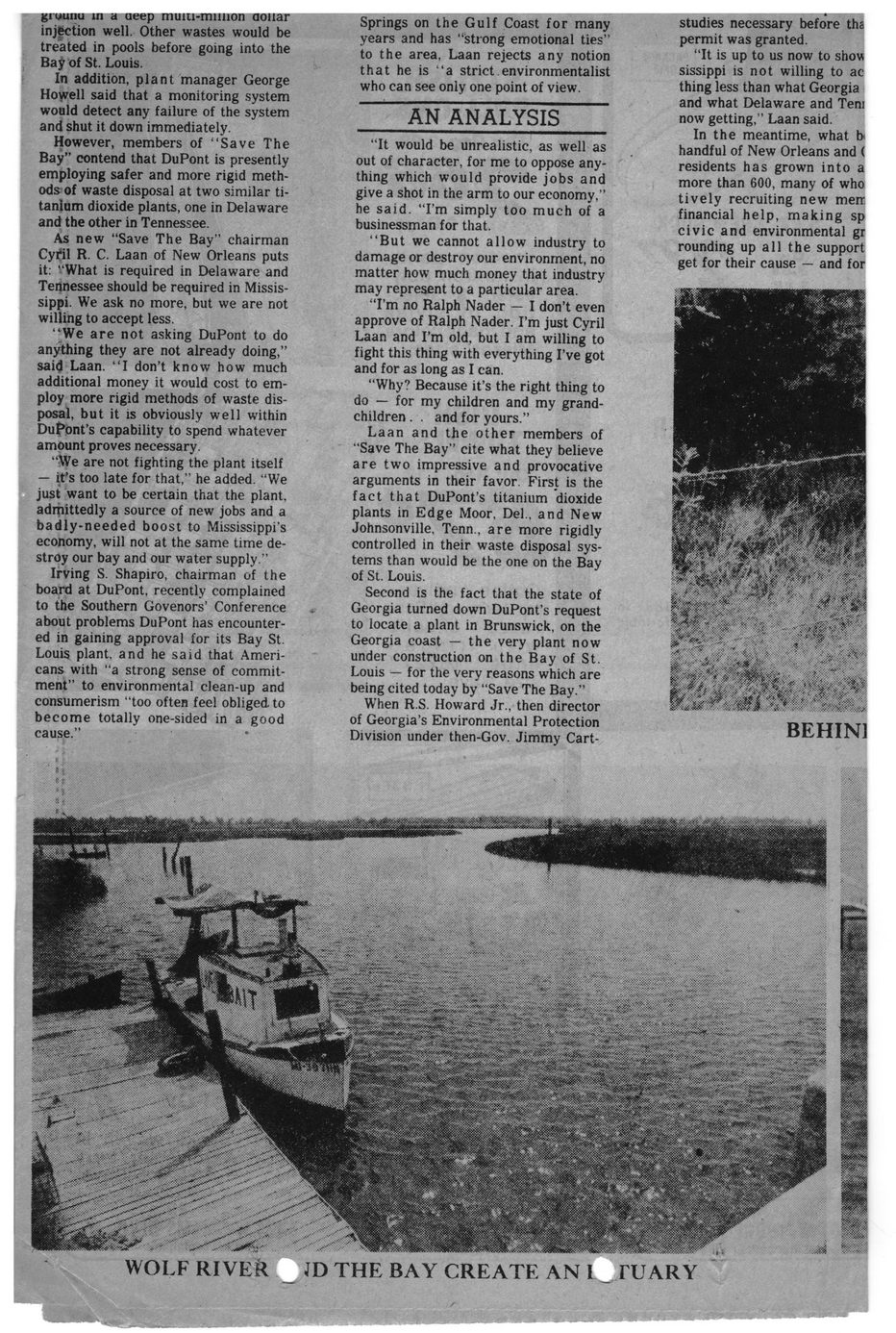This text was obtained via automated optical character recognition.
It has not been edited and may therefore contain several errors.
grwum ill ■ oeep muiu-nuuion dollar injection well. Other wastes would be treated in pools before going into the Bay of St. Louis. In addition, plant manager George Howell said that a monitoring system would detect any failure of the system and shut it down immediately. However, members of “Save The Bay” contend that DuPont is presently employing safer and more rigid methods of waste disposal at two similar titanium dioxide plants, one in Delaware and the other in Tennessee. As new “Save The Bay" chairman Cyrtl R. C. Laan of New Orleans puts it. \‘What is required in Delaware and Tennessee should be required in Mississippi. We ask no more, but we are not willing to accept less. “We are not asking DuPont to do anything they are not already doing,” said Laan. “I don’t know how much additional money it would cost to employ more rigid methods of waste disposal, but it is obviously well within DuPont’s capability to spend whatever amount proves necessary. “We are not fighting the plant itself — it’s too late for that," he added. “We just want to be certain that the plant, admittedly a source of new jobs and a badly-needed boost to Mississippi's economy, will not at the same time destroy our bay and our water supply." Irving S. Shapiro, chairman of the board at DuPont, recently complained to the Southern Govenors’ Conference about problems DuPont has encountered in gaining approval for its Bay St. Louis plant, and he said that Americans with “a strong sense of commitment” to environmental clean-up and consumerism "too often feel obliged to become totally one-sided in a good cause.” Springs on the Gulf Coast for many years and has “strong emotional ties” to the area, Laan rejects any notion that he is “a strict environmentalist who can see only one point of view. AN ANALYSIS “It would be unrealistic, as well as out of character, for me to oppose anything which would provide jobs and give a shot in the arm to our economy,” he said. “I’m simply too much of a businessman for that. “But we cannot allow industry to damage or destroy our environment, no matter how much money that industry may represent to a particular area. “I’m no Ralph Nader — I don’t even approve of Ralph Nader. I’m just Cyril Laan and I’m old, but I am willing to fight this thing with everything I’ve got and for as long as I can. “Why? Because it’s the right thing to do — for my children and my grandchildren . . and for yours.” Laan and the other members of “Save The Bay” cite what they believe are two impressive and provocative arguments in their favor. First is the fact that DuPont’s titanium dioxide plants in Edge Moor, Del., and New Johnsonville, Tenn., are more rigidly controlled in their waste disposal systems than would be the one on the Bay of St. Louis. Second is the fact that the state of Georgia turned down DuPont’s request to locate a plant in Brunswick, on the Georgia coast — the very plant now under construction on the Bay of St. Louis — for the very reasons which are being cited today by “Save The Bay.” When R.S. Howard Jr., then director of Georgia’s Environmental Protection Division under then-Gov. Jimmy Cart- studies necessary before thi permit was granted. “It is up to us now to show sissippi is not willing to ac thing less than what Georgia and what Delaware and Tew now getting," Laan said. In the meantime, what b< handful of New Orleans and ( residents has grown into a more than 600, many of who tively recruiting new merr financial help, making sp civic and environmental gr rounding up all the support get for their cause — and for #f ‘' v < , BEHIN] WOLF RIVER JD THE BAY CREATE AN L_TUARY

Delisle Document-(05)